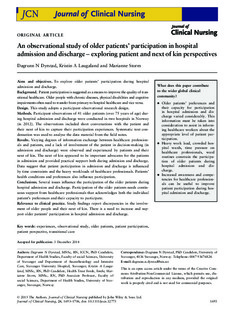An observational study of older patients’ participation in hospital admission and discharge - exploring patient and next of kin perspectives
Journal article

Åpne
Permanent lenke
http://hdl.handle.net/11250/2485722Utgivelsesdato
2015Metadata
Vis full innførselSamlinger
Originalversjon
Dyrstad, D. N., Laugaland, K. A. & Storm, M. (2015). An observational study of older patients’ participation in hospital admission and discharge - exploring patient and next of kin perspectives. Journal of Clinical Nursing, 24(11-12), 1693-1706. 10.1111/jocn.12773Sammendrag
Aims and objectives: To explore older patients’ participation during hospitaladmission and discharge.
Background: Patient participation is suggested as a means to improve the quality of tran-sitional healthcare. Older people with chronic diseases, physical disabilities and cognitiveimpairments often need to transfer from primary to hospital healthcare and vice versa.
Design: This study adopts a participant observational research design.Methods. Participant observations of 41 older patients (over 75 years of age) dur-ing hospital admission and discharge were conducted in two hospitals in Norway(in 2012). The observations included short conversations with the patient andtheir next of kin to capture their participation experiences. Systematic text con-densation was used to analyse the data material from the field notes.
Results: Varying degrees of information exchange between healthcare profession-als and patients, and a lack of involvement of the patient in decision-making (inadmission and discharge) were observed and experienced by patients and theirnext of kin. The next of kin appeared to be important advocates for the patientsin admission and provided practical support both during admission and discharge. Data suggest that patient participation in admission and discharge is influencedby time constraints and the heavy workloads of healthcare professionals. Patients’health conditions and preferences also influence participation.
Conclusions: Several issues influence the participation of the older patients duringhospital admission and discharge. Participation of the older patients needs contin-uous support from healthcare professionals that acknowledges both the individualpatient’s preferences and their capacity to participate.Relevance to clinical practice. Study findings report discrepancies in the involve-ment of older people and their next of kin. There is a need to increase and sup-port older patients’ participation in hospital admission and discharge.
Utgiver
Journal of Clinical NursingTidsskrift
Journal of Clinical Nursing
Med mindre annet er angitt, så er denne innførselen lisensiert som Navngivelse-Ikkekommersiell 4.0 Internasjonal
Beslektede innførsler
Viser innførsler beslektet ved tittel, forfatter og emneord.
-
Long-term patients’ outcomes after intermediate care at a community hospital for elderly patients: 12-month follow-up of a randomized controlled trial
Garåsen, H.; Windspoll, R.; Johnsen, R. (Journal article, 2008)Background: Developing a better understanding of if, and when, patients need care at a general hospital is an urgent challenge, as the proportion of general hospital beds being occupied by older patients is continuously ... -
Mental health and substance use problems among patients in substance use disorder treatment as reported by patients versus treatment personnel
Bergly, T.H.; Hagen, R.; Gråwe, R.W. (Journal article, 2015)Objective: We examined and compared mental health and substance use problems among patients in substance use disorder treatment as reported by both patients and treatment personnel, and explored the feasibility of the ... -
The Liverpool Care Pathway: discarded in cancer patients but good enough for dying nursing home patients? A systematic review
Husebø, Bettina S.; Flo, Elisabeth; Engedal, Knut (Journal article, 2017)Background The Liverpool Care Pathway (LCP) is an interdisciplinary protocol, aiming to ensure that dying patients receive dignified and individualized treatment and care at the end-of-life. LCP was originally developed ...
